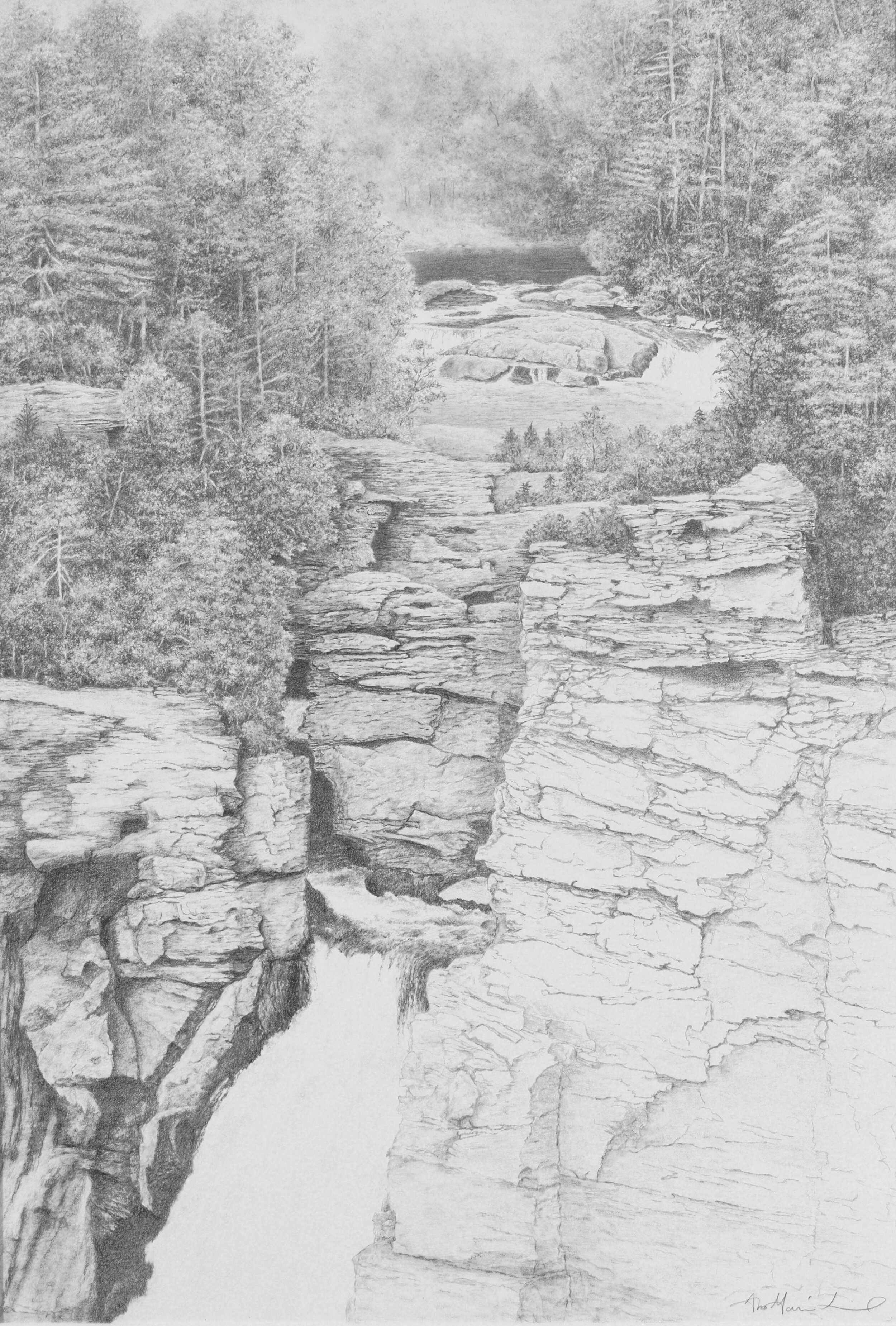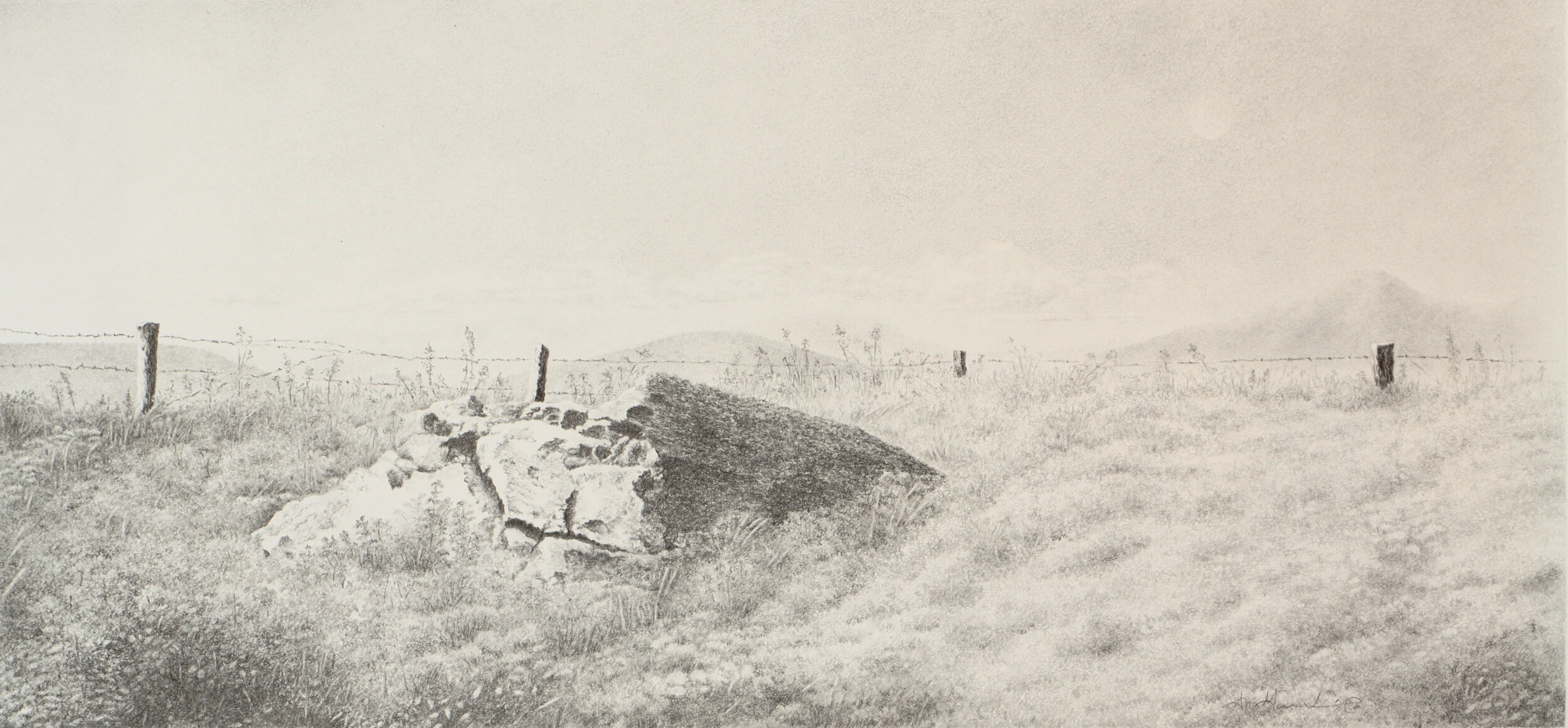
BLUE RIDGE SONNETS
ANAMARIE LIDDELL
October 1 - November 20, 2020
ARTIST SPOTLIGHT
AND INTERVIEW
AnaMarie Liddell’s work is a meditation on the beautiful complexity of the natural world. Depicting a liminal space that is at once real and imagined, the artist’s lush-yet-monochromatic landscapes are perhaps best described by what they don’t include: people and animals. With the exception of birds silhouetted across the distant sky, her trees, rocks, and streams reflect pregnant moments of contemplative stillness. In the video and written interview below, the artist and exhibition curator Anna Pillow discuss Liddell’s artistic practice, inspirations, and the works that make up her Blue Ridge Sonnets series.
You come from an artistic family. What made you decide to carry on the tradition and become an artist yourself?
Art has always been a passion and a part of my life. Both of my parents encouraged my siblings and me in our artistic endeavors and from an early age we often went on family visits to museums. My father, who was an engineer by profession, pursued his love of art both by studying the masters and by his own practice of drawing, painting and sculpting. One of my most treasured memories is my father teaching me how to draw when I was just nine years old.
“My hope is that viewers of my work will experience their own feeling of peacefulness as they walk through the exhibition.”
How has your practice changed over time?
I have studied and worked in many mediums and techniques but I always return to drawing for it is there that I find my true self. I love using graphite pencils. It feels more natural to me than any other medium. The act of making marks is meditative and, like tending a Zen garden, it allows me to contemplate and be at one with the world. Over time my compositions have become more complex as I strive to interpret the majesty, awe, and wonder of the natural world. At the same time my technique has evolved into a more direct depiction of my deepest thoughts and feelings and in the attempt to get to the essentials I have eliminating all references to color. I think black and white images resonate and appear timeless, forcing me to rely on my imagination, memories and experiences. Working monochromatically by manipulating and emphasizing darks and lights and the many tones in-between is an intricate problem posing many challenges.
What led you to create the Blue Ridge Sonnets series?
My life is a complete involvement rooted in the landscape that I call home – the fields, trees, mountains, and streams of the Blue Ridge Mountains. Like a lyric poem that expresses personal emotions, I want to capture and express the lyrical journeys I feel in the landscape where the ordinary is transcended and the world of mysterious silence is evoked.
What is your process when you create these imagined landscapes? Are they based on real places?
My work is based on actual scenes – sort of. On my journeys through the landscape a scene before me will give a glimmer of a thought or feeling. I make sketches or take photos of that instant and then let the image marinate until it coalesces into a composition. I don’t necessarily draw what I see, I rely on a mixture of facts and feelings that lead to altering many aspects of the original scene. But I maintain that first moment in my mind’s eye and as the pencil meanders over the surface of the paper it is as though my eyes and my moment are at one with the pencil
What is your favorite aspect of this series? Is there one piece that best exemplifies this aspect for you?
The freedom to draw what I see without any other intention then just rendering the experience of the simple moments of nature’s intrinsic beauty and serenity is pure joy. On my many wanderings through our beautiful landscape I am always awed by the abstract quality of the shapes and lines of trees or hills or rocks and how the sunlight creates its myriad and endless patterns. It’s very liberating to create my own reality. I can circumvent the two-dimensional plane of the paper surface to engender a depth that takes me into an illusion of boundless space and time. It’s difficult to choose a personal favorite but of the works on display Blue Ridge Sonnet #38, #47 and #48 certainly come closest to my vision.
Has the COVID-19 pandemic changed the way you work or think about your art?
I am very fortunate to have a studio in our secluded home located in the hills of Albemarle County. My daily work practice has not been directly affected by the pandemic but it does provide a needed solace during these tragic times. I am saddened and think more than ever of the importance of reinforcing our intimate relationship, respect, and preservation of the natural world. My hope is that viewers of my work will experience their own feeling of peacefulness as they walk through the exhibition.
Blue Ridge Sonnet #18 (2018), 14 x 14 inches, 24 x 24 inches (frame), AVAILABLE
Blue Ridge Sonnet #21 (2018), 12 x 24 inches, 22 x 23 inches (frame), AVAILABLE
Blue Ridge Sonnet #22 (2018), 16 x 42 inches, 23 x 49 inches (frame), AVAILABLE
Blue Ridge Sonnet #28 (2018), 22 x 31 inches, 28 x 37 inches (frame), AVAILABLE
Blue Ridge Sonnet #37 (2019), 26 x 18 inches, 32 x 24 inches (frame), AVAILABLE
Blue Ridge Sonnet #38 (2019), 12 x 26 inches, 18 x 32 inches (frame), AVAILABLE
Blue Ridge Sonnet #44 (2020), 14 x 35 inches, 19 x 40 inches (frame), AVAILABLE
Blue Ridge Sonnet #45 (2020), 32 x 21 inches, 27 x 38 inches (frame), AVAILABLE
Blue Ridge Sonnet #47 (2020), 12 x 37 inches, 18 x 43 inches (frame), AVAILABLE
Blue Ridge Sonnet #49 (2020), 12 x 32 inches, 18 x 38 inches (frame), AVAILABLE
Blue Ridge Sonnet #50 (2020), 30 x 44 inches, 36 x 50 inches (frame), AVAILABLE
ANAMARIE
LIDDELL
Born in the Netherlands into a family with a rich artistic tradition, AnaMarie Liddell continues to be influenced and inspired by her heritage and memories. In her drawings, she reflects the Dutch tradition of respect for nature, love of flowers, and delight in simplicity. All her thoughts and ideas are inspired by nature for it is there that her personal version of reality comes alive. She translates her thoughts and ideas into metaphors through pictorial forms so that her art becomes the fulfillment of her inner vision.
After graduating from Sweet Briar College with a degree in studio art and a certification in arts management, AnaMarie pursued her art while also working as the Exhibitions Manager at the UVA Art Museum. She now works exclusively in her own studio located in rural Albemarle County.
A world of mysterious silence is evoked in her drawings through structure, space, and the quality of light. She isolates a purely aesthetic space, recalling the classical quest for simplicity, balance, and formality with a romantic longing for evocations of mystery and dreams. The drawings appear to be passive, but in reality they are a complete meditative involvement with seemingly simple scenes. The scenes function as iconic references to her own world and are placed for creating the drawings’ own internal rhythm.
Meaning and verification of the drawings are not in what they describe but in the depth of consciousness they expose. The works awaken innate enlightened states to reveal their own meaning through contemplation and awakening one’s heart. She uses many grades of graphite pencils, building layer upon layer with delicate strokes and nuances, developing gradated tones to create an ethereal, serene image of simplicity and timelessness.
Blue Ridge Sonnets is supported in part by the Virginia Commission for the Arts and the National Endowment for the Arts.

















